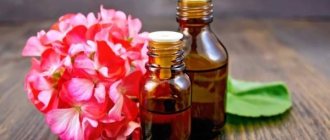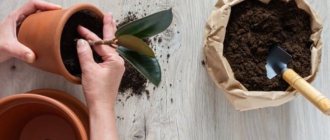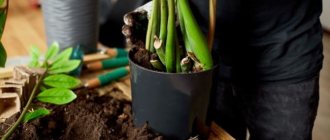Castor oil for watering indoor flowers
Castor oil is obtained from the seeds of the castor bean or northern palm. This plant is listed in the Guinness Book of Records website as the most poisonous in the world. The culture was found a long time ago, but an antidote to it has not yet been invented. All parts of the castor bean are dangerous, but it is the seed that poses the greatest danger.
But in the process of production and use of castor oil, all the negative properties of the plant are eliminated, and the oil provides only benefits and fertilizer. Not so long ago, castor oil began to be used to feed plants at home: indoors and garden plants. After the correct manipulations have been made, the crops grow more actively, and the abundance of their flowering increases significantly.
A person must spray his garden or various vegetable gardens.
The product contains a lot of acids, especially the following:
- linoleic fatty acid (polyunsaturated);
- palmitic and stearic fatty acids;
- oleic and ricinoleic acids.
These are the main components and stimulants of the product, providing its beneficial properties.
Positive properties and effectiveness of use in floriculture
The unique properties of castor bean seeds - the fruits from which castor oil is obtained for fertilizer - remained in the shadows for a long time, so they began to be used in floriculture recently. Due to its dense and viscous properties, it has been used in medicine for quite a long time, primarily as an antiseptic and a strong laxative. This product is also indispensable in cosmetology - creams, hair care products and decorative cosmetics often include it in their composition.
Castor oil is used in medicine, cosmetology, for making cosmetics, and now as a flower fertilizer.
It is not at all surprising that in small doses the admixture is life-saving for plants. The popularity of this approach is explained by a number of exceptional characteristics:
- does not disintegrate in petroleum products;
- dries out slowly;
- hardens at temperatures down to -20°C;
- easily decomposes in alcohol solution;
- does not leave stains from combustion.
Flower growers claim that a large number of beneficial properties of castor oil make it possible to practically resurrect dying plants. As a rule, after transplanting a flower into a new pot, the useful particles last for a maximum of 2-3 months, and then additional feeding is extremely important. What to do? Replanting plants again is undesirable and even dangerous. After all, for flowers this is stress and an additional risk of damaging the root system. This is where castor oil comes to the rescue.
This type of feeding of indoor plants guarantees an improvement in their condition in an average of 5-10 weeks.
VIDEO: 6 natural fertilizers for your home greenhouse
Recipe for using the product
It is very easy to prepare an effective growth and flowering stimulator based on castor oil yourself. To do this, combine a teaspoon of the product with a liter of mineral (non-carbonated) water and mix the ingredients thoroughly. Ordinary tap water is also suitable, which should be pre-settled.
The oil is diluted in water and poured over with this solution.
The resulting mixture for feeding indoor plants should be treated with a spray bottle on the leaves or watered with the roots every 5 days until complete recovery.
It is best to fertilize a home greenhouse at the time of bud formation - it will help increase the flowering process and even fruit set.
Before you start fertilizing your home flowers, you should remember that in certain periods the flowers go into a state of suspended animation - hibernation. In fact, this time period is notable in that growth and maturation are not as noticeable as before.
It happens that the mentioned sleep state can be accidentally confused with nutritional deficiency or damage. After all, external signs are similar and risk confusing. In this case, castor oil for flowers is strictly contraindicated. To avoid such mistakes, you should first make sure that such intervention is necessary.
Recommendations for product selection and storage
Reviews from flower growers about the effectiveness of castor oil for nourishing plants indicate that this product should be purchased not in cosmetic stores, but in a pharmacy. For feeding indoor plants, the most popular in terms of price and quality is castor oil labeled “sulfated castor oil.”
What are the benefits of castor oil for plants?
After properly feeding the plant with castor oil, the following positive changes in crop growth are observed and carried out, for example:
- the growth rate of plants and leaves increases, buds also appear faster, their size becomes larger;
- known damaged instances are restored faster;
- the crop will better consume useful components from the soil mixture;
- the plant gets sick less due to enhanced immunity and there are no pests;
- the appearance of green mass and flowers becomes much more attractive;
- the composition of the soil improves, water and air permeability increases;
- active growth and cell division begins;
- metabolism improves;
- roots absorb and deliver nutrients faster.
The name of this oil is castor
What is this product?
Castor oil is obtained from a plant called castor bean. The culture itself is extremely poisonous; consumption of its fruits, even in small quantities, can lead to death in humans. But during the production of a castor bean product, all toxins are inactivated, so that the final composition becomes harmless, and sometimes even beneficial.
Castor oil is a mixture of triglycerides, linoleic, oleic and ricinoleic acids. The name apparently comes from the word "castoreum", meaning in English beaver stream, which was replaced with the oil in question. The product is also sometimes called ricin oil.
The consistency of the substance is a viscous transparent or yellow liquid. The smell is weak and the taste is unpleasant. The substance freezes at -16 °C and boils at +313 °C. The product does not oxidize in the light, does not dry out, and when burned, disappears without a trace; petroleum products do not dissolve it.
When castor oil gets into the soil:
- Accelerates the ripening of buds.
- Activates plant regeneration.
- Acts as an antibacterial agent.
- Accelerates the delivery of nutrients from the soil.
- Helps plant growth.
- Restores lifeless flowers.
- Accelerates the process of cell division.
- Improves soil composition.
When should you water flowers with castor oil?
The growth of indoor plants differs from garden plants in that it is limited by the size of the pot and, if necessary, it is not always possible to obtain nutrients, since the soil may already be poor. That is why indoor crops most often require additional feeding and fertilizer.
The use of castor oil and substances is justified and is not canceled in the following cases:
- the stems of the crop are thin and often break;
- leaf blades wither for no apparent reason;
- the green mass has become drooping, dull, new parts practically do not appear;
- the growth of plants and leaves stands still;
- the plants have undergone numerous transplants;
- the rhizome is damaged (in this case, you first need to remove the damaged parts and only then begin rehabilitation of the flower).
Hobbyists are responsible for the result of the fertilizer and that it accelerates the formation of antibacterial fruits
Help and comment! When the listed negative signs appear, the plant needs at least three months to fully recover, so the application of oil should not be stopped after 1-2 weeks. A competent restoration process of feeding is not a quick matter.
Recommended watering times
Healthy plants and shoots are fertilized once every 30 days as a preventive measure. It is better to do this during or after the soil blooms.
If the culture needs restoration, it is allowed to apply castor oil every two weeks for three months.
Useful video
Find out in the video why castor oil is used for orchids: Interesting facts in the video about aspirin: Video review about the substrate Aurica Gardens:
Find out in the video what multiflora is:
To make the plants bloom even more beautifully and luxuriantly, gardeners recommend fertilizing during the budding period. One of these fertilizers is castor oil, thanks to which flowering becomes lush and longer, and the flower heads turn out to be large and get a more saturated color.
Preparation: Fill a liter plastic bottle with settled water at room temperature and add 1 tsp to it. castor oil. Next, close the lid tightly and shake the contents thoroughly. Castor oil should be broken into small fractions and mixed well with water so as not to burn the roots of the plant. Immediately after shaking, before the castor oil rises, water the flowers.
If the plant blooms once a year, then one such feeding is enough. If the plant blooms constantly, then you can feed them with castor oil once a month.
Phalaenopsis is an epiphyte that grows on a tree; it does not need soil. These orchids grow at home in bark without adding soil. If you see bark with added soil on sale, it’s for terrestrial orchids. Not for your orchid! Look for clean bark. If the bark is taken from the forest, it must be boiled. it's too labor intensive. The pots must be transparent with holes, as the roots are involved in photosynthesis.
Place it on the sunny side, but protect it from direct sun with a translucent curtain, otherwise there will be burns.
In the summer, you often water your other indoor flowers with a hot shower, it’s very useful! except for those with pubescent leaves.
After this, be sure to blot the growth point with a cotton swab to remove all the water, otherwise the phalaenopsis will rot.
After the store, the new orchid must be inspected after being removed from the bark. Cut off all rotten places to the healthy part of the root and sprinkle thickly with cinnamon (it acts as an antiseptic)
Phalaenopsis blooms for up to 7 months. The peduncle is laid under the condition of a temperature difference of 5*C day/night, which happens in August. Moreover, in winter you need lighting up to 12 hours of daylight.
In general, these are very unpretentious flowers that please the eye for a very long time! It takes a long time to explain, but it’s easy to care for them!!
Many gardeners, wanting to help their indoor plants enrich themselves with useful substances, buy expensive fertilizer compounds. However, there is a simple and inexpensive means for feeding home flowers, the effect of which will be no worse than the advertised compositions. We are talking about castor oil. It turns out that it can be used to improve the condition of indoor plants. We'll look at how to water flowers with castor oil in this article.
How to choose plant oil
It is best to buy castor oil at pharmacies, where it is always in stock and is sold even at a reasonable price. It is better to avoid purchasing from retail outlets, since aromatic components that are harmful to the crop may be added to the oil. You should only choose a product of high quality.
Fertilizers will make cells stronger and stimulate disease prevention
The best option is cold-pressed oil (it retains the maximum amount of useful components). The product obtained after hot extraction is not purchased, because its production may involve the use of chemicals that are harmful to the crop and which can cause dormancy.
Fertilizer selection criteria
To check the authenticity of the product, a few drops of it are dissolved in clean water. If the product is natural, no oil film should form.
It is also important to pay attention to the shelf life of the product - it should not be more than two years. After the expiration date, there is no point in buying oil, since it will not give any effect, and in some cases it may even be harmful. Castor oil is stored in a cool place, ideally in the refrigerator.
Recipes for use
Castor oil can be used for both root and foliar feeding. There are several simple, but proven and effective recipes for preparing fertilizer.
Important! Remember that using oil in its pure form is under no circumstances allowed. Such manipulation will immediately lead to a chemical burn of the crop. Therefore, castor oil must be prepared before application. Castor oil can be combined with other types of oils, so the effect of applying fertilizer only increases.
It is important to spray correctly against diseases
First recipe:
- prepare 1000 ml of clean, settled water at room temperature;
- add a teaspoon of oil to it and stir everything thoroughly so that no oily greasy traces remain (it is better to immediately perform the procedure in a spray bottle);
- the plant is pre-irrigated with ordinary clean water (the green part, the buds, and the soil);
- after two hours after moistening with clean water, begin spraying with an oil composition (the more abundant the spraying, the more effective the procedure will be).
This treatment is suitable for the period of active vegetative growth and the budding period. In winter, it is better to abandon the procedure, since most crops at this time enter the dormant stage and are restored.
The second application option involves mixing castor oil with other components to increase the composition of nutritional components. Therefore, oil is added not to water, but to other useful solutions. Most often, the necessary ingredients are found in every home. For this you will need:
- mix the oil with the liquid that remains after defrosting the meat (5 ml of castor oil is enough for 100 ml of such liquid);
- combine the oil product with any organic components, including manure (in a ratio of 1:10);
- add butter to milk (a teaspoon of castor oil per liter of dairy product) - it is advisable to take milk at room temperature);
- mix the oil with wood ash and dissolve it all in warm, settled water.
Wear gloves when caring for the plant
It is recommended to choose one of the options and use it once a month for prevention and once every two weeks to restore the culture.
Stimulating flowering
To produce castor oil, castor beans are used, which contain a large amount of useful substances. The concentrated product can be used for root and external feeding. It is an excellent alternative to expensive chemicals, allowing you to improve the condition of plants in a short time by providing additional nutrition.
To prepare a nutrient solution to stimulate the flowering process, you need to mix oil and water in a ratio of 1 tbsp. l. per 1 liter of liquid. It is important to shake the container well before use to obtain a homogeneous composition and use the fertilizer immediately after preparation. A slight delay can lead to the fact that after a couple of minutes the castor oil will begin to separate.
Luxurious Homemade roses for 147 rubles (advertising)
Instructions: how to water flowers with castor oil
In order for the fertilizer to bring maximum benefit, experienced gardeners advise adhering to the following instructions:
- carefully dissolve the oil in any liquid, avoiding contact of pure oil with parts of the flower (chemical burns cannot be avoided in this case);
- adhere to the recommended timing and dosage of fertilizer;
- use the prepared mixture immediately, shaking it well (it is not recommended to store the fertilizer);
- It is better to let the water for the recipe sit for a week;
- do not feed during suspended animation.
Advice from flower growers
The following recommendations in the article will help you use castor oil to its maximum benefit:
- the best time to apply castor oil is during budding at any hour;
- root fertilizing will give the maximum beneficial effect and should be carried out;
- Before using the oil solution, be sure to moisten the plant and soil;
- for full growth and development of the crop, it is enough to fertilize every month;
- You cannot store the finished mixture, as it loses all its beneficial properties;
- Before each spraying, the container with the solution and yeast is thoroughly shaken so that the oil particles do not collect into one mass;
- if the crop blooms and dries out only once a year, then fertilizer is applied only once a year;
- In no case should you increase or cancel the frequency of use or dosage, as this most often leads to clogging of the pores of the greens and a deterioration in the process of ricin photosynthesis.
Reference! Negative reviews most often appear due to mistakes by the flower growers themselves, so you should not overdo it with oil.
Useful properties for plants in the garden and at home
If you keep a northern palm tree in your garden, you can get rid of numerous pests. Caterpillars and harmful insects avoid it, much less lay eggs in the tissues of this plant.
Feeding flowers with castor oil, according to reviews from lovers of ornamental plants, leads to a rapid recovery of sick or wilted crops. This happens due to its antibacterial properties.
The substances cleanse the leaves and roots of pathogenic microorganisms, thereby giving the immune system a break and start working. As a result, the plant recovers naturally.
Beneficial microflora in pots is often absent due to improper fertilizing, because organic matter is not added to the soil. Only plant residues can provide food for soil bacteria. Fertilizing with mineral fertilizers alone leads to depletion of the humus layer and disease.
As a result of just one feeding:
- metabolism improves;
- the root absorbs nutrients and water better;
- intensive cell division and growth begins.
You can use castor oil for ornamental plants in open ground, as it is quite stable in the external environment and does not dry out. It is absorbed on the leaves, but does not form a film, that is, it does not interfere with respiration processes.
Video: Recipe for miraculous flower food
By adding the solution to the soil, pests leave it. Castor oil can be used to treat the mulch before laying it down for the winter so that the overwintering larvae of harmful insects die.











